Photo Gallery: Fiji
/1 Comment/in Article, Fiji, Oceania, Photo /by May SuenSigatoka
Sigatoka is the main market town and “capital” of Viti Levu’s Coral Coast. It is situated on the main Queen’s Highway, almost exactly half way between Nadi and Suva, and at the mouth of the Sigatoka River. Sigatoka itself is a bustling little town with a thriving market. Whilst there are shops catering to day trippers from the Coral Coast’s resorts and hotels, there is no real tourist accommodation in the town itself, so it remains a very local town. Two or three ‘super’markets around the market square, a busy bus station, small shops, hardware and farm supplies, vehicle parts and repairs, pharmacies and shoe shops, tailors and hairdressers and second hand clothes all dot this area.

Harinam Sankirtan, a weekly event where devoted disciples chant the holy names of Krishna or God or chant the Hare Krishna Maha-Mantra, “Hare Krishna Hare Krishna Krishna Krishna Hare Hare Hare Rama Hare Rama Rama Rama Hare Hare” to reach self-realization and to bring blessings around the Sigatoka town from the Krishna Temple.

Krishna dancers in Sigatoka

Krishna dancers in Sigatoka

International Society of Krishna Consciousness (ISKCON) Krishna Temple perched high up on the hill in Sigatoka which cost FJ $6 million to build

Delicious vegetarian lunch at the Radha Krishna Temple Restaurant in Sigatoka

Shrine for His Divine Grace Srila Tamal Krishna Goswami Gurudev aka “Srila Gurudeva” by his many disciples and “Goswami” by his godbrothers and members at the Krishna Temple

Artwork depicting a story of Krishna’s teachings

Sigatoka Market vendors selling an array of fruits and vegetables

Sugar cane sellers at the Sigatoka Street Market

For sale at the Sigatoka Market, super small, but super spicy peppers and paw paw (or papaya)

Women holding up her orange-stained hand at the Sigatoka Market probably from mashing turmeric

Sigatoka Market vendor selling a variety of root vegetables, staple food of Fiji

Master woodcarver carving boats of different sizes to sell as souvenirs
View the Entire Sigatoka Gallery
Namatakula Village
Namatakula literally means “the place of the snake.” The village, Namatakula, is incorrectly spelled on all records. On their arrival Nagwatakula, the correct traditional spelling, pronounced Namwatakula, the Rogoua Clan saw a bright orange snake, thus the name “Nagwatakula.” Snakes on Viti Levu have since been wiped out by the mongoose. Namatakula Village is located on the Coral Coast, halfway between the main towns of Nadi and Suva. It is known to be one of the more prosperous villages on Fiji with a population of over 600 people, over 100 houses, two churches, a primary school, and a gym to be built for producing several rugby legends.

The Methodist Church built in honor of Reverend Thomas Baker, who was the first and only missionary in Fiji to be killed an eaten by cannibals of another tribe.

Sisters hanging out at the Namatakula Village while watching over some of the kids of the village

Children playing in the Namatakula Village

One ball, many kids, easily entertained

Joshua lifting this kid up like he’s superman

Child giving two thumbs up for the fun experience of being a super hero

Having fun pointing at each other

Schoolwork displayed outside a classroom of the only school, a primary school called Ratu Filise in the village

One of the one hundred houses in the village. In the front on the right is a tombstone for the deceased and chickens roam rampant here.

View of a house from a cement wall which houses glass beer bottles for recycling.

Another house with mother and son chatting

Kids hanging out on the porch at the village

Namatakula Village contains many dogs which run rampant. Here are two dogs that just finished copulating and haven’t detached yet.

A child hanging outside of their house

View of the church through the front porch

Enjoying a kava ceremony with Oni, at the village chiefs house

Joshua, one of the chiefs of the day, trying out Kava for the first time.

The kava plant. The root is the prized possession which grows near the surface
View the Entire Namatakula Village Gallery
Garden of the Sleeping Giant
The Garden of the Sleeping Giant contains a beautiful orchid garden of more than 2,000 varieties that was started by late actor Raymond Burr who is most famous for his role as Perry Mason on American TV.

Walkway through the orchid gardens

Hanging orchid






Pineapple

View the Entire Garden of the Sleeping Giants Gallery Here
Sabeto Hot Springs and Mud Pool
We arrived here after visiting the orchid gardens. We hired a private taxi driver to take us here so we can get dirty and then get clean. First we slather mud from a bucket all over ourselves, then we let the breeze dry the mud on our skin, while helping with cooling off in the heat. Then we proceed into the mud pool where we walked through a knee-deep mish mash of mud, underwater flora, and warm water coming up from the spring. After we rinse ourselves from the mud, we move onto the hot springs, where it was much warmer on one side.

Slathering mud and letting it air dry to cool us down at the Sabeto Mud Pools and Hot Springs

Soaking in the Sabeto Hot Springs
Resort Activities
We stayed in the Beachside Bure at the Mango Bay Resort on Fiji’s Coral Coast which featured many free activities.

Mango Bay Resort, Beachside Bure

Polynesian Dance

Polynesian Dancers

Making coconut shell jewellery
Hello and New Friends in Fiji
/2 Comments/in Adventure, Culture, Fiji, Life, Oceania, Travel Tips /by Joshua HawleyWalking along the beach, enjoying the setting sun on our last night in Fiji, a man named Dunedin, sitting on a log with his friend says “hello” and calls us over for a chat. A new friend was made and on a wonderful night I’ll never forget, began.
One simple word can open many doors and bring people into your life like no other I know of. Along this journey we have met many people and had some great conversations that would have never happened without first saying hello. When we first began the trip, we were both nervous when it came to meeting new people, our busy lives before felt like we had little time to venture out of our comfort zones as it took all our energy to cope with the grind of the 9 to 5 routine, so approaching strangers and overcoming our fear of the unknown was something we would have to get used to and get used to fast. Part of it was from fear instilled from news media, but most of it was from the isolated lifestyle we lead while enduring the rat race and catering to unending to-do lists.
The First Hellos
Staying at the Mango Bay Resort in the Coral Coast for the first part of the trip was an easy way to begin opening up and talking to new people since we had to introduce ourselves during group activities, but this was done in a safe and fun environment. It was during our trip to the town of Sigatoka that we would have to put our fear of meeting strangers behind us. After eating lunch at the local Krishna temple we began to make our way back to the main part of town and to the pick up point for our ride back to the resort. As we walked down the road from the temple and began to pass by some houses, we hear “hello” come from the other side of a fence. A little hesitant, we took a couple more steps before we heard “hello” again as a man stepped out of the opening of a yard and then asked if we would like to join him and his buddies for a drink and some snacks. Even though we were both a little nervous and apprehensive, we decided to accept the offer and followed him into the yard and sat down next to a small open fire where him and his coworkers were cooking some food after a days work. It turned out that we were at his bosses house and he would soon came out to join us. After a having a glass of Fiji Gold, the beer of the island, and some snacks, we began to talk about where we were from and they explained that they had just finished work and this was there Saturday routine after finishing their 6 day work shift. It is interesting how small of a world it can be as the boss told he had a daughter who lived in Milpitas, California, a city near where we used to live, and we talked about the places he had visited during his trips to California. Though we couldn’t stay long as we had to be at the pick up point soon or we would miss our ride back to the resort, it was a good experience that helped us begin to overcome some of our fears. This was something I was grateful for a few days later when I would meet Dunedin.
Dunedin’s Welcome
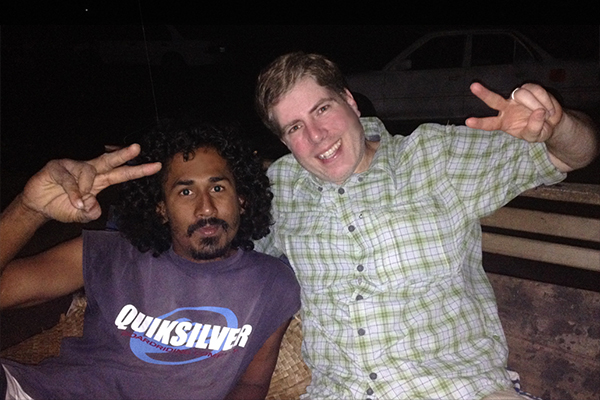
Dunedin, our new friend, and third generation Indo-Fijian slave.
When Dunedin called us over to talk as we spent our last night in Fiji walking along the beach, I had no idea we were in for one of the more interesting conversations we have had so far on this journey. Dunedin immediately got my interest when he said he was a third generation descendent from slaves. Fiji is comprised of two main ethnic groups, native Fijians and Indo-Fijians who were brought to the islands as indentured servants by the British to work in extremely bad conditions on the sugar cane plantations. I had been curious to learn the Indo-Fijian perspective of life knowing that they been a persecuted minority. He invited us to join him for some Kava and dinner. We couldn’t pass up the opportunity so we walked over to the house where he was staying with his uncle, Mr. Ahmad and his family. Their house was one of the few houses located away from the other residents without light pollution, near the beach.
Upon arriving at the house, he showed us the boat that his uncle was building. As we looked at the partially completed hull he explained that when it was finished, they would use it to take tourists out for fishing trips or ferry them to resort islands. It was impressive to see a boat being built by hand. The family was in the business of repairing boats and motors all over the island.
Sitting outside in the yard, we chatted and enjoyed a bowl of Kava, Dunedin told us of his life. Dunedin didn’t have much to his name and didn’t need nor desire much, other than to fulfil his one goal in life. He slept in a shed consisting of nothing other than the four sheet metals propping another sheet metal roof over his head and a piece of plywood as the door to prevent the wild dogs from devouring him while he slept, he said had everything he needed. Shelter, food fresh from the ocean, clothing, and income he received while he worked on maintaining his uncle’s boats to achieve his dreams was enough to satisfy him. His possessions were meagre and only consisted of a backpack which held his prized binocular, a National Geographic magazine featuring China’s people, and a few other books he had acquired from people he befriended in a similar manner he did with us. Dunedin explained his main goal is to save up enough money to get to China and to meet a wife while there and if he didn’t find one there, he would go to Mongolia.
Captivating Conversations
When the Kava was finished we hopped in his cousins car and proceeded to head to the store to get more Kava powder and the ingredients for that nights dinner, which we decided would be chicken curry with rice. As his cousin drove us to the store we were amazed that he seemed to know so many people, and would shout hello to people walking and even some driving while operating a vehicle. When we returned from the store, his uncle was outside sitting down waiting for us so he could talk.
May was directed into the house by Dunedin to help with the cooking (she thought that was kind of sexist) but from what she said, she shared an equally delightful conversation with the women who lived on the property. While the men stayed outside, started a fire to keep warm under the trees, smoked, drank Coke and snacked on cheese, they enjoyed another bowl of Kava all while conversing about many topics.
Mr. Ahmad
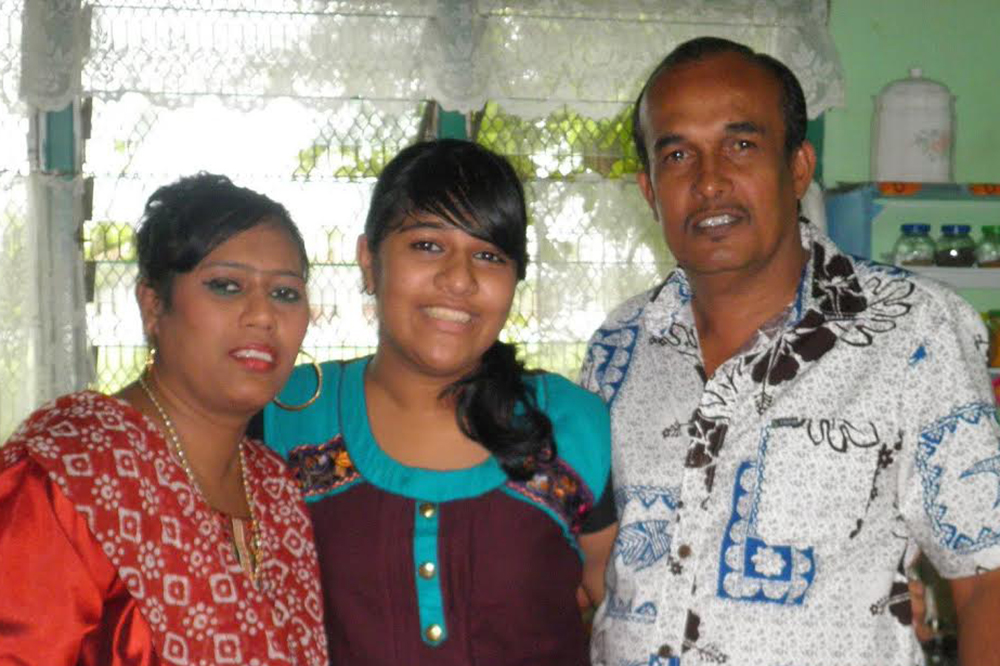
Mr. Ahmad and his wife (left) and daughter (right).
Dunedin’s uncle, Mr. Ahmad is an interesting man who had many things to talk about. My conversation with him quickly turned to politics, discussing current events such as Iraq and he asked if I thought the country was better off now or under Saddam Hussein’s rule. This question I have often asked myself since I was involved in the invasion of the country in 2003 during my time in the Navy. I explained that I don’t think it is better off and the war should have never been started. He said that Saddam was bad but what has now replaced him is much worse. He felt that there needed to be sensible people in government and when there wasn’t people, bad decisions are made. After politics we turned to discussing life and spirituality. We both seemed to agree that God is nature, Earth. To me it is our mother and that all living creatures are manifestations of her. There is an energy that flows through us all and binds us together. At this point May came out to join us and the conversation turned towards Indo-Fijian history.
Indo-Fijian Slavery
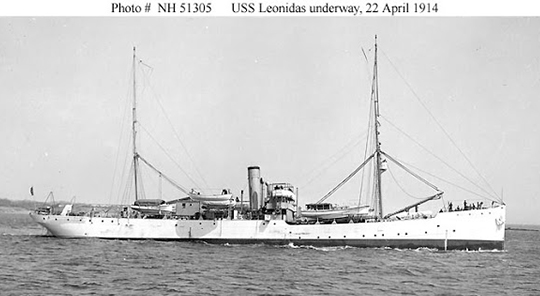
USS Leonidas is the first ship that arrived in Fiji on 14 May, 1879 with 497 indentured labourers (Girmitiyas). Source: Fiji Pundit
During the period of 1879-1919, 60,965 Indian indentured laborers were brought in from all parts of India to Fiji to not only work on the sugar cane plantations but also the rice paddies, with many dying on the ship during the journey from India. The slave system was brutal, forcing men and women to work the fields even if the women were pregnant and to live in squalid and degrading conditions in the camps. The workers were generally illiterate and the system came to be known as ‘Girmit’ (derived from the word ‘agreement’), and later were known to be called ‘Girmitiyas.’ The system required them to work for five years with little or no pay at which point they had the option to return to India or stay. Many stayed since they couldn’t afford to return to India. The ratio of men to women at this time was 5:1 which made things difficult on the plantations. This is why so many people knew each other, they had to share the same women, he explained. Due to these conditions, many different castes lived together and made the caste system obsolete with people changing religions. After independence, life for Indo-Fijians was not easy and the tensions between the native Fijians and Indo-Fijians has resulted in three military coups that either sought to reduce or increase the rights of Indo-Fijians which still continues today. The situation, he said, seems to be getting ever so slightly better as the government tries make all citizens equal. The Indo-Fijian experience comes from a complicated history and I tell from our conversation there are still many tensions underneath the surface of Fijian society.
World’s Largest Diamond Stolen from India
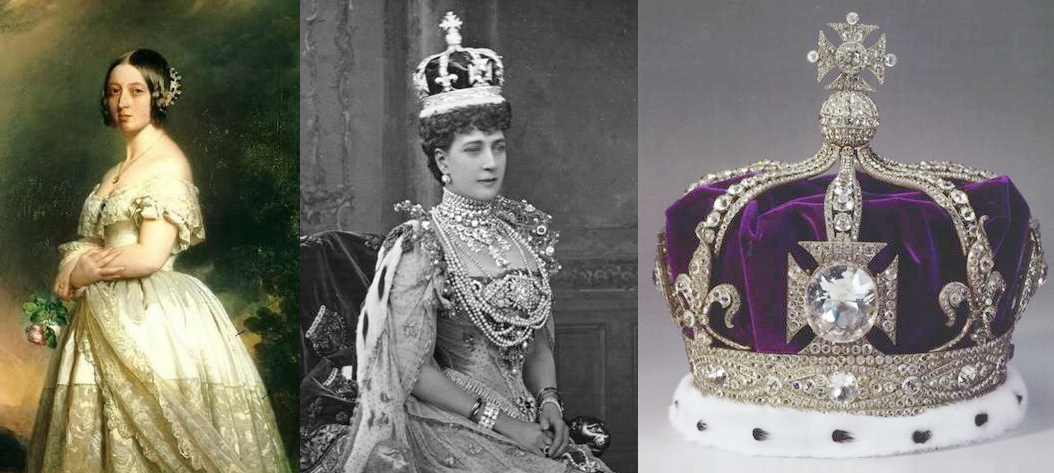
Left to right: Queen Victoria wearing the Koh-i-Noor as her brooch; Queen Alexandra wearing the Koh-i-Noor set front and center on the Royal Crown; The Royal Crown on display along with the other British Crown Jewels in the Tower of London.
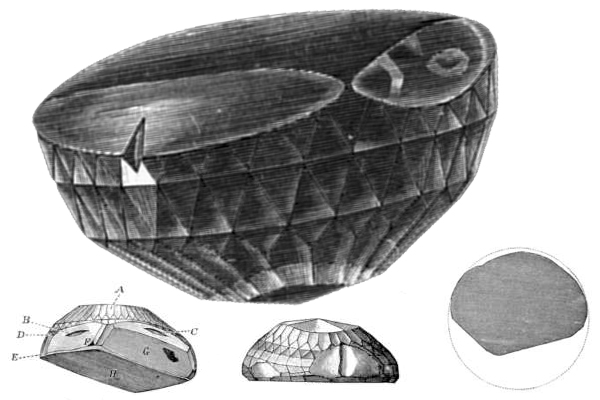
Tavernier’s illustration of the Koh-i-Noor under different angles.
One of the more interesting parts of the night’s conversation was his explaining British history in regards to India. When the British came to India they took as much gold as they could and shipped it back to England just like they did with every colony. Because of this, England has the most reserves of gold in the world and the reason the British Pound is the most valuable currency in the world. Not only did they take gold from India but they also took what was once known as the largest diamond in the world from India called the Koh-i-Noor or ‘The Mountain of Light.” Legend says that the emperor Shāh Jahān positioned the Koh-i-Noor near a window on the Tāj Mahal, so he could see it by looking at its reflection in the stone. This diamond had been stolen many times, but ultimately was stolen and cut down from 793 carats uncut, to 186 1/16 carats (37.21 g) and then again to its current 105.602 carats (21.61 g) and placed in Queen Victoria’s brooch, and later the Royal Crown. Dunedin mentioned that the diamonds were divided into nine pieces. From an uncut 793 carats to 105 carats, we’re not sure where the rest of the diamond went. We hope to visit the Tāj Mahal to see where the Koh-i-Noor was once placed.
Three Things in Life
At the end of the night Mr. Ahmad asked us three important questions, which I found to be pretty clever with the answers below.
1. What is the tastiest thing on Earth?
2. What is the worst thing anyone must endure?
3. What is the most comfortable?
After eating a delicious meal, we headed back to our hostel and got ready for our early morning flight to Australia. I’m glad we stopped and walked over to Dunedin when he said hello otherwise we would not have met his Uncle and family or had gotten to learn what is like to live in Fiji if only for one night. Meeting local people is one of the best ways to experience a culture where you can learn what the daily issues they face and that even though we come from different places we all seem to have similar dreams, to love and be loved while also having a sense of belonging.
Answers:
1. Salt
2. Stomach, because it drives us to do everything, good or bad, because we need to eat
3. A bed because nothing beats laying down after a hard days work or when you are sick
Bula and Welcome to Fiji!
/6 Comments/in Adventure, Culture, Fiji, Oceania /by May SuenBula! That means hello in Fijian and you will hear this word, along with the word vinaka which means thank you and also you’re welcome everywhere you go in Fiji. Everyone here is so friendly and they all say it is because they run on what the locals call “Fijian time” or “island time,” where everything operates at a slow pace, without official schedules, completely opposite from the city. We have a hunch that the nightly kava ceremonies where kava, a beverage mixed with water, created from a powder from a dried root of a plant may have something to do with it as well. Locals can typically consume 20 bowls and more a night to achieve a full-body numbing effect. Even the first drink will begin to take effect and start numbing your tongue and lips.
Welcome to Fiji and Bula!
Upon landing at Nadi International Airport we didn’t know exactly how to get to our accommodation at Mango Bay Resort but people were more than helpful here. We mentioned we wanted to take the local bus to Mango Bay Junction and a man helped us locate not one but three buses and helped us board the first one that came. We took the bus for $9.35FJD or $4.50USD for 2.5 hours and were entertained with music and beautiful views including seeing random cows, horses, dogs, cats, goats, and chicken on the side of the road enjoying their luxurious buffet.
Namatakula Village
We arrived at Mango Bay Resort and called the front desk to pick us up. We were shown to our beachfront bure, it wasn’t exactly on the beach as we were set back by a row, but it was good enough for us to spend a few days resting and relaxing. The resort took us on a tour of the village down the road, Namatakula Village. Namatakula village is one of the wealthier and larger villages on the main island of Viti Levu with a population of around 300-400 residents with its own church and school. When the British colonized Fiji they introduced Christianity which is what the majority population practices today and something they seemed grateful for. Prior to that, cannibalism dominated the society during what they referred to as “the dark time.”

Children playing in Namatakula Village

Two sisters who live in the Namatakula Village

Playing Superman
Near the end of the tour or guide introduced us to the Kava Ceremony, a traditional drink on Fiji. There is a saying, “You haven’t been to Fiji if you haven’t tried kava.” Kava is a powder ground from the root of the kava plant. One bag costs $1FJD and it takes 5 bags to make a bowl. The kava powder is poured into cloth and water is then strained through the cloth. We were given a weaker mix to try for our first ceremony. The effects of the drink are to first numb the tongue and lips, then as more is consumed it will numb your head and move towards the rest of your body. Kava is consumed nightly as a ritual in just about every household. We were told that Kava makes for a better ‘lava’ (lover) unless you have had too many in which you will be walking sideways due to your body being numb.

Oni, mixing our kava drink.
Sigatoka
The next day we went for a visit to the town of Sigatoka and walked through the market to see the variety of local fruits and vegetables. When we got off the bus we were greeted by a group from the local Krishna Temple who were dancing. After walking through the market, our curiosity of the Krishna’s got to us and we decided to go to the Krishna Temple for a nice vegetarian lunch and to tour the temple.

Krishna Dancers
After our visit to town, it began to rain but that didn’t stop us from having fun with Polynesian dancers who came to perform and we even got to participate with them. May had fun shaking her butt with the dancers, and so did I. It rained for the next couple of days so we decided to move to the town Nadi (pronounced nan-di) where the airport is and where the weather was better. This time we stayed in a hostel on the beach called Bamboo Backpackers that was filled with backpackers and had a different vibe to it, a little more of a party atmosphere, and was my first time staying at a hostel.
Fiji’s Valley of the Sleeping Giant
Finally getting over my jet lag we set out the last day we had in Fiji to visit the Valley of the Sleeping Giant to stop the orchid garden that was started by Raymond Burr who is most famous for his role as Perry Mason on American TV. Strolling around the garden was relaxing and fun. I had never been to an orchid garden and found the garden to be very peaceful with all the interesting flowers and their beautiful colors.

Garden of the Sleeping Giant

Garden of the Sleeping Giant
Fijian Mud Bath and Hot Spring
Having worked up a sweat walking through the garden, we headed down the road for a refreshing dip in the mud bath and mineral pool at Sabeto Hot Springs and Mud Pools. After changing into our swimsuits, we covered each other with mud, letting it dry which felt tight on our bodies while it cooled us off a bit before entering the mud pool. It is hard to cover yourself in mud without thinking that you look silly but as we began to do that a van pulled up and a couple from the UK and two ladies from Australia joined us for the experience making it a bit more fun. Walking down the steps and stepping into the mud at the bottom of the pool felt like wading through grass, not sure if that is what it was or just the unfamiliar sensation of walking through mud, we slowly made our way over to one edge of the pool where some rocks that we could sit on were located. As we felt for the rocks the warmth of hot water rushing into the pool could be felt and we proceeded to rinse the mud off of ourselves by splashing and dunking our bodies with the muddy water. Having cleaned as much mud as possible off of ourselves, the mineral pool called for us as some light rain began to fall. Taking in the scenery and letting our bodies relax in the hot water was wonderful. The area is called Valley of the Sleeping Giant because the mountain range surrounding it looks like a giant laying on its back which was fun to look at while we floating and relaxed in the hot water of the pool not wanting our time on Fiji to end.

Covered in mud at the Sabeto Hot Springs and Mud Pools
Departures and Arrivals
/0 Comments/in Article, Fiji, Travel Tips /by May SuenDAY 1 and 2 – DEPARTURES AND ARRIVALS
April 28-29, 2015
Journey to the Past and to the Future
We have finally begun our newest journey to travel the world together! We met on eHarmony, an online dating site, attempted to buy a house and condo (but failed miserably due to being outbid from multiple offers and rising home ownership prices), to then finding an apartment and moving in together. Our love of travel led us to complete numerous road trips throughout the neighboring states of California including Oregon, Nevada, Arizona, and Utah, travelling overseas to Japan to meet Josh’s Japanese family. After getting engaged at Crater Lake, planning our wedding, getting married in the forest at the Redwood Regional Park in a months time, quitting our jobs, and moving out of our 2 bedroom apartment and getting rid of most of our stuff feels like the last three years has been a whirlwind of an adventure already.
Our New Home, From 850 sq ft to a 65L Backpack
Deciding to downsize and travel was an easy decision considering the rising rent we faced each year to lease what we called our home, a 2-bedroom 850 sq ft apartment in the sleepy and foggy coastal town of Pacifica, CA near San Francisco. We quickly learned that it is not as expensive to travel as we had thought. With some planning and budgeting we figured we could travel the world for about the same cost as just putting a roof over our head in the SF Bay Area.
Downsizing to a 65L backpack was a little more challenging than we had imagined it would be. It is amazing the amount of stuff a person accumulates over the course of ones life. After asking ourselves “do we own our stuff or does our stuff own us” we decided to donate or sell most of our possessions. The hardest part was deciding what was important to keep took as we seemed to have emotional attachments to the things we owned. But as each item disappeared from our lives we could could the weight of those emotions leave with them. It feels amazing to to have been able to consolidate down from 850 sq ft to 65L or 2.3 cubic feet at 35 lbs! We will surely miss everyone back home, but we are excited to start on this journey to travel and see the world.
Pre-Departure Anxiety
It was an adventure just to get the journey started. We nearly missed our flight because even though our flight departed at 6PM, I wanted to head to the airport at 3PM just in case security checkpoint was long. We managed to arrive at 4PM, though we went to the wrong terminal. We thought we were going to go to International Departures, but ended up finding out that because we have a layover at LAX, it was really a Domestic Departure, which was in terminal 2, on the far opposite side of SFO! We asked an airport staff how to get there and he said with a sigh showing the journey was long, we had to take a tram, and walk to the other side. I felt like we were on Amazing Race and had to race against the clock. Fortunately, I rushed back outside and found my mom still there, so we hopped in and she took us to the right place.
American Airlines’ Flight Delay Due to an Anomaly
Our flight arrived on time, we had all boarded the plane and were seated, until the pilot said there was an “anomaly” that he has never encountered before and we needed to head back to the gate. Turns out American Airlines were early adopters to use iPads on their flights so they could be more efficient by not printing flight charts and they are legally required to have 1 of 2 working iPads before taking off. Both iPads didn’t work. Then the pilot found out it was a systemwide error where all pilots of American Airlines were grounded due to an update glitch. So we went back to the terminal to wait and their back up plan is to run the Apple update again, and also have someone deliver a printed flight chart to them. After waiting at the tarmac for an hour and a half, we finally took off and arrived. Good thing our layover was for 4 hours, and we wouldn’t miss our next flight to Fiji.
More Legroom Please
Our next leg of the journey was to board Fiji Airways for an 11 hour red-eye flight from LAX to NAD, or Nadi, Fiji. The flight was painstakingly long. I’m 5’8″ and Josh is 5’10” and we barely had enough leg room once the people in front reclined. I had about 10″ of personal space before the monitor on the head rest reached my face or 3″ of space from my knee to the seats. How do taller people fly? The airline, however, did provide us with a pillow, blanket, headphones, and two (mediocre) meals. Once I discovered that the restroom had 3x’s as much space, I deliberately found excuses to get up to go to the bathroom to stretch and hang out there. Though Fiji Airways was a cramped ride, the flight did go smoothly, no delays, nice staff, and we arrived safely. I ended up watching “Kingsmen” and part of “Ex Machina” on the flight when I wasn’t drifting in and out of sleep or going to the bathroom to hang out there. Upon arrival we were greeted with a Fijian musical group, flowed through customs smoothly, and arrived right at baggage claims to retrieve our bags. It was a small airport and there was no room to get lost. Upon arrival, we were greeted with a big Bula (hello) and Welcome from a Fijian music group. We knew then we were now in Fiji!
